Related Research Articles
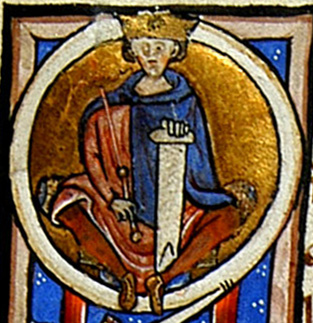
Alfonso Jordan, also spelled Alfons Jordan or Alphonse Jourdain (1103–1148), was the Count of Tripoli (1105–09), Count of Rouergue (1109–48) and Count of Toulouse, Margrave of Provence and Duke of Narbonne (1112–48).

Alfonso II, called the Chaste or the Troubadour, was the King of Aragon and, as Alfons I, the Count of Barcelona from 1164 until his death. The eldest son of Count Ramon Berenguer IV of Barcelona and Queen Petronilla of Aragon, he was the first King of Aragon who was also Count of Barcelona. He was also Count of Provence, which he secured from Douce II and her would-be father-in-law Raymond V, Count of Toulouse, from 1166 until 1173, when he ceded it to his brother, Ramon Berenguer III. His reign has been characterised by nationalistic and nostalgic Catalan historians as l'engrandiment occitànic or "the Pyrenean unity": a great scheme to unite various lands on both sides of the Pyrenees under the rule of the House of Barcelona.

Aimeric or Aimery de Peguilhan, Peguillan, or Pégulhan was a troubadour born in Peguilhan, the son of a cloth merchant.
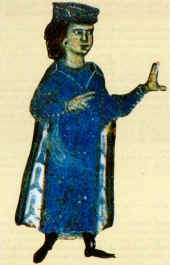
William IX, called the Troubadour, was the Duke of Aquitaine and Gascony and Count of Poitou between 1086 and his death. He was also one of the leaders of the Crusade of 1101. Though his political and military achievements have a certain historical importance, he is best known as the earliest troubadour—a vernacular lyric poet in the Occitan language—by whom some work survives.
The count of Toulouse was the ruler of Toulouse during the 8th to 13th centuries. Originating as vassals of the Frankish kings, the hereditary counts ruled the city of Toulouse and its surrounding county from the late 9th century until 1270. The counts and other family members were also at various times counts of Quercy, Rouergue, Albi, and Nîmes, and sometimes margraves of Septimania and Provence. Count Raymond IV founded the Crusader state of Tripoli, and his descendants were also counts there. They reached the zenith of their power during the 11th and 12th centuries, but after the Albigensian Crusade the county fell to the kingdom of France, nominally in 1229 and de facto in 1271.
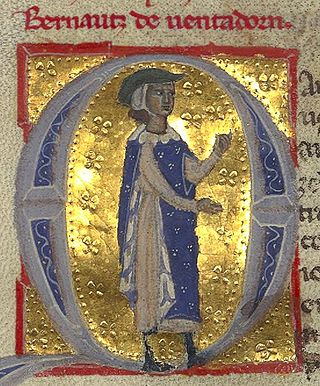
Bernart de Ventadorn was a French poet-composer troubadour of the classical age of troubadour poetry. Generally regarded as the most important troubadour in both poetry and music, his 18 extant melodies of 45 known poems in total is the most to survive from any 12th-century troubadour. He is remembered for his mastery as well as popularization of the trobar leu style, and for his prolific cançons, which helped define the genre and establish the "classical" form of courtly love poetry, to be imitated and reproduced throughout the remaining century and a half of troubadour activity.
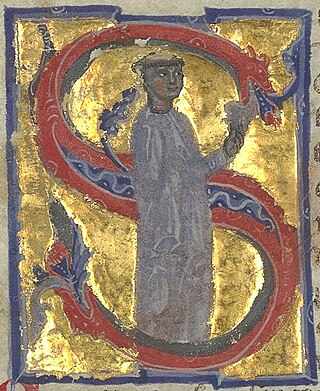
Arnaut de Mareuil was a troubadour, composing lyric poetry in the Occitan language. Twenty-five, perhaps twenty-nine, of his songs, all cansos, survive, six with music. According to Hermann Oelsner's contribution to the 1911 Encyclopædia Britannica, Arnaut de Mareuil surpassed his more famous contemporary Arnaut Daniel in "elegant simplicity of form and delicacy of sentiment". This runs against the consensus of both past and modern scholars: Dante, Petrarch, Pound and Eliot, who were familiar with both authors and consistently proclaim Daniel's supremacy.
William IV of Toulouse was Count of Toulouse, Margrave of Provence, and Duke of Narbonne from 1061 to 1094. He was the son of Pons of Toulouse and Almodis de la Marche. He was married to Emma of Mortain, daughter of Robert, Count of Mortain, who gave him one daughter, Philippa.
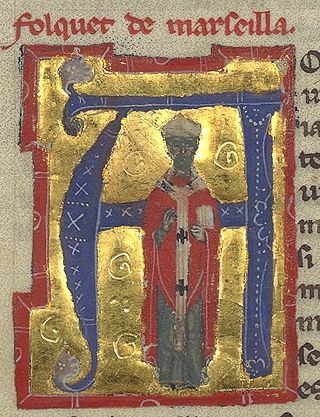
Folquet de Marselha came from a Genoese merchant family who lived in Marseille. He is known as a troubadour, and then as a fiercely anti-Cathar bishop of Toulouse.

Peire Cardenal was a troubadour known for his satirical sirventes and his dislike of the clergy. Ninety-six pieces of his remain, a number rarely matched by other poets of the age.

Peire Vidal was an Old Occitan troubadour. Forty-five of his songs are extant. The twelve that still have melodies bear testament to the deserved nature of his musical reputation.
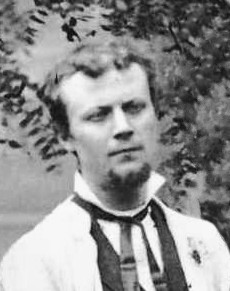
Alfred Jeanroy was a French linguist.

Peire Raimon de Tolosa was a troubadour from the merchant class of Toulouse. He is variously referred to as lo Viellz and lo Gros, though these are thought by some to refer to two different persons. On the other hand, lo Viellz could refer to his being of an early generation of troubadours. Eighteen of Peire Ramon's poems survive, one canso with a melody.
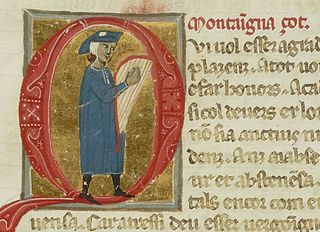
Guilhem de Montanhagol was a Provençal troubadour, most likely active in Toulouse, but known in the courts of Provence, Toulouse, Castile, and Aragon. Guilhem left behind seven cansos and six sirventes. He also left behind one tenso with Sordello and his total surviving output comes to fourteen pieces.
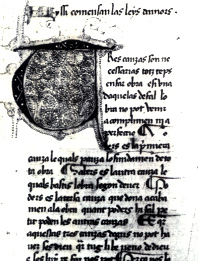
The Consistori del Gay Saber was a poetic academy founded at Toulouse in 1323 to revive and perpetuate the lyric poetry of the troubadours.
Arnaut de Cumenges was a Gascon nobleman, the brother of Count Bernard IV of Comminges. He took part in the war against Albigensian Crusade, participating in the defence of Toulouse in 1218. He was also a troubadour, who wrote a sirventes beginning Be·m plai us usatges. He was still living in 1246.
Bernart Arnaut d'Armagnac, also Bernard Arnaud, was a troubadour and from 1217 the Count of Armagnac in opposition to his brother, Gerald V, who inherited it from the childless Gerald IV. Bernart and Gerald were both sons of Bernard de Fézensaguet.
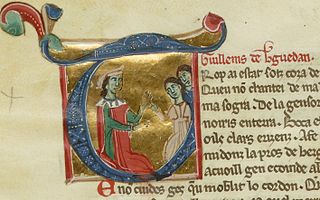
Guillem de Berguedà (c.1130–1195/6; fl.1138–1192), or Guilhem de Berguedan in Occitan, was a Catalan troubadour and viscount of Berguedà. He was the most prolific Catalan poet of the twelfth century, though he composed in Occitan, and thirty-one of his poems survive. Most are sirventes, "typically violent and obscene, reflecting his character and turbulent life," but there are a few cansos. Most of what is known about him derives from his vida and his songs.

Joseph Anglade was a French philologist. He specialized in Romance languages, particularly Occitan, and studied the lyrics of the troubadours. He was instrumental in formalizing the term Occitan for the language of Provence.
Eleanor of Aragon, Countess of Toulouse (1182–1226) was a daughter of King Alfonso II of Aragon and Sancha of Castile. She married Raymond VI, Count of Toulouse.
References
- Anglade, Joseph (1928). Les troubadours de Toulouse. Toulouse: Privat.